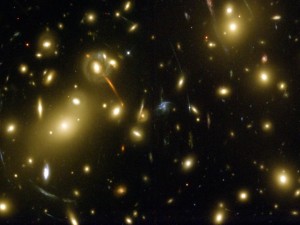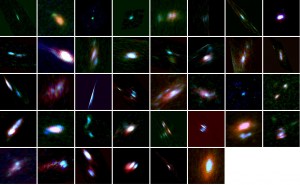Some of the primary questions in extragalactic astronomy concern the formation and evolution of galaxies in the distant Universe. In particular, little is known about the less luminous (and therefore less massive) galaxy populations, which are currently missed from large observing surveys and could contribute significantly to the overall star formation happening at early times. One way to overcome the current observing limitations prior to the arrival of the future James Webb Space Telescope or the European Extremely Large Telescopes is to use the natural magnification of strong lensing clusters to look at distant sources with an improved sensitivity and resolution.
The aim of CALENDS is to build and study in great details a large sample of accurately-modelled, strongly lensed galaxies at high redshift (1 < z < 8) selected from a sample of massive clusters fields, and compare them with the more luminous samples or the lower redshift populations. We will develop novel techniques in this process, in order to improve the accuracy of strong-lensing models and precisely determine the mass content of the clusters. By performing a systematic modelling of the cluster sample we will look into the relative distribution of baryons and dark matter as well as the amount of substructure.
Regarding the population of lensed galaxies, we will study their global properties through a multiwavelength analysis covering the optical to millimeter domains, including spectroscopic information from new instruments, such as MUSE and KMOS on the Very Large Telescope or ALMA. We will study the global properties of this sample and look for scaling relations between the stellar, gas and dust parameters, which we will compare with known relations for lower redshift and more massive galaxy samples. We will use predictions from numerical simulations to determine the interplay between these three galaxy components and the evolution history of galaxies at different masses and redshifts. For the most extended sources, we will be able to spatially resolve their inner properties, such as their morphology, kinematics, stellar population content, and compare them with predictions from high resolution numerical simulations. We will then look into the key physical processes: star formation, gas accretion, inflows and outflows in distant galaxies.

